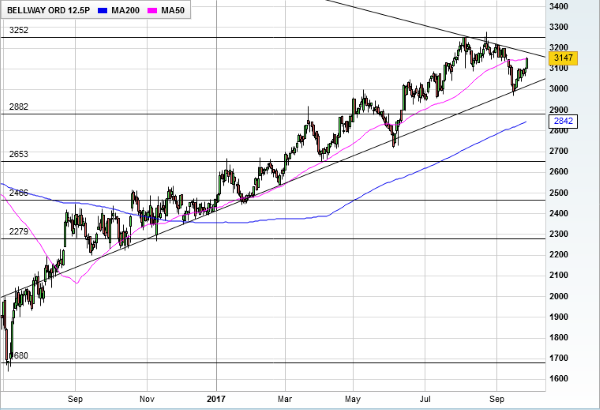'Stay overweight' this housebuilder
27th September 2017 18:01
by David Brenchley from interactive investor
Share on
Having built up a head of steam since collapsing in the immediate aftermath of the Brexit vote, the UK's dozen home construction stocks have endured a tough September.
From close on the Friday after the referendum to the end of August 2017, all bar one - - had posted share price gains in excess of 25%. However, month-to-date, they have given up chunks of that recovery. In fact, only two – and – are in the green for September.
But some still have cheerleaders in the City – Neil Woodford being one example, having bought the likes of recently.
Explaining the attraction of housebuilders, Neil Hermon, manager of Money Observer Rated Fund Henderson UK Smaller Companies trust, tells us that it looks good valuation-wise, with "high attractive yields, low PE [price/earnings ratios] and the price/book is good".
Further, the wider context is helpful, "helped by the government promotion of Help to Buy and structurally we're undersupplied in housing in the UK so we need to build more houses". "As long as affordability remains OK and the UK consumer doesn't fall over we think the housebuilding sector's pretty well set," Hermon, whose joint biggest holding is , adds.
And broker Barclays put forward a compelling case for "staying overweight" Bellway Wednesday. Having climbed to a record high 3,280p towards the end of August, it proceeded to hit a nine-week low under £30 on 15 September.
That looks to have been a bottom for now, though, and it's back up to 3,147p. And Barclays' target price of 3,631p suggests upside of around 15%. It reports full-year results in three weeks, which could be a catalyst for a further move higher to test those all-time highs once more, argues the broker.

Indeed, we've spelled out the case for Bellway a few times thanks to a couple of its other fans both after June's upbeat trading update and a further vote of confidence from UBS.
Volume growth of more than 10% is no mean feat for a housebuilder doing around 9,000 annual units, says analyst Jon Bell.
The Help to Buy argument is pertinent to Bellway as its average selling price of a forecast £264,000 in 2018 is lower than many of its peers, meaning Help to Buy usage is significant. That scheme should stick around until at least 2021.
Meanwhile, housebuilders' return on average capital employed (ROACE) and price/tangible net asset value (PTNAV) correlate strongly – "this makes sense as the higher the returns generated by assets, the more the market should be prepared to pay for them". Bellway's forecast 2018 ROACE of 23% more than supports a PTNAV of 1.5 times.
Going back to Hermon's argument of low PE's and high yields, Bell notes that Bellway trades on 7.8 times forward earnings and yields 4.3%. Dividend cover of 3 times means that's within its means and Bellway was the only name in the sector to pay a dividend during the financial crisis, he adds.
"We see Bellway as one of a trio of pure housebuilders screening as attractive," concludes Bell. The other two in his top picks are and .
This article is for information and discussion purposes only and does not form a recommendation to invest or otherwise. The value of an investment may fall. The investments referred to in this article may not be suitable for all investors, and if in doubt, an investor should seek advice from a qualified investment adviser.